Ground Rules
-
- THE CIRCLE OF RELIANCE " I n Time of War, Land, Sea, and Air Forces and All Logistic Support Functions Must Work as a Team" Maritime Reporter, Jun 1985 #50
A conclusion stated in the 1983 Annual Report as to the prospects that commercial merchant marines will not, in the future, meet national security requirements and a statement of the maritime problem that must be solved both remain valid.
They are: "CONCLUSION—Due to dramatic shifts both in commercial markets and government policies, here and abroad, commercial markets that have previously been relied upon to provide sealift, shipbuilding, and shiprepair assets required to fulfill national security objectives can no longer be relied upon to provide these assets." " P R O B L E M S T A T E M E N T— Faced with the above conclusion, how should the nation provide (1) sealift assets in sufficient quantity and possessing operational characteristics as determined by national security demand, and (2) shipbuilding and shiprepair capability and capacity defined as essential to meet national security needs—both at lowest cost in toto?" A solution to the problem is demonstrably required.
In time of war, land, sea, and air forces and all logistic support functions must work as a team. Military commanders must be able to assess with accuracy their commands' abilities and insure that these capabilities work in concert with companion forces and support functions to achieve defined objectives.
It is assumed that both the ability to work jointly and required support capabilities exist. Unfortunately, these fundamental requirements are not tested by analyzing the ability of all interlocked components to support each other. Civilian leaders are not expert in such determinations, while military leaders are neither empowered nor expected to judge the capabilities of companion force and support functions. Indeed, beyond military capability, we assume that very substantial support elements are and will remain available from non-military sources, both government and commercial in our nation and those of our Allies.
The U.S. does not have a system that provides overall coordination of military needs with industrial capacity.
Our principal adversary does. Instead, the U.S. has a "Circle of Reliance" where each service assumes that "If I'm okay, you're okay" and that all required non-military support functions, including those of our Allies, are also okay.
Consider the maritime element of the Circle. The Army, Air Force, and Marines rely on the Navy to provide military sealift. The Navy relies on its controlled assets and on the Department of Transportation (DoT) to fulfill responsibilities under the Merchant Marine Acts to provide ships, men, and shipyards needed to meet sealift needs. The DoT relies on the White House direction—both to insure the availability of our Allies' large shipping and shipbuilding resources and to set policy under which DoT can perform its statutory duty to maintain required U.S.-controlled shipping and shipbuilding assets—and the Administration relies on the Navy, Army, Air Force, and Marines to maintain forces necessary to defend the nation. The circle goes around and around. Is the untested reliance justified?
The Administration has adopted a maritime policy that severely limits support of commercial shipping and shipbuilding. It is assumed without analysis and test that Navy and commercial support will, under existing ground rules, provide sufficient assets to meet wartime demands.
The Navy has become highly concerned that these policies will not provide the required U.S. sealift needs. However the Navy, in seeking to build its combatant fleet, logically rejects the diversion of its limited fund resources to provide national assets that heretofore have been provided without significant cost to the Navy. The Army, Air Force, and Marines assume that deployment and logistic support needs will be met, but have no means to insure that this is so.
It is assumed that the entire dry cargo sealift to support a NATO crisis will be provided from the fleets of NATO Allies. These Allies rely almost exclusively upon commercial forces to provide the ships and shipyards needed to support their sealift commitments. The shipping and shipbuilding assets of the principal NATO Allies are in rapid decline.
Specifically, the adoption of the UNCTAD Code of Conduct for Liner Conferences by most of the world's trading nations, and its rejection by the U.S., have consequences upon our NATO Allies that have never been factored into forward defense planning and the development of international defense strategies.
If the Circle of Reliance is analyzed, logic compels the conclusion that the ability of our military to effectively use force capabilities being provided may fail for want of sealift and shipyard resources only assumed to be available.
-
- Maritime for the Win(d) Marine News, Nov 2021 #23
key steps that need to be taken to accelerate this process.First, American offshore wind and maritime need to mutually understand and acknowledge the ground rules. In the case of offshore wind vessels, Congress has spoken—as recently as January 1—with legislation clarifying that the Constitution
-
- He's No Regular Joe Maritime Reporter, Mar 2004 #30
at night than in the city. The floor moves! The service provided by the crew is at a high level seldom found at hotels. What a fantastic set of ground rules to begin a design. So the idea in designing in such an environment is to not do anything that takes away from these great advantages over hotels
-
- EUROPE 1992: WHAT LIES AHEAD FOR U.S. COMPAHIES? Maritime Reporter, Dec 1989 #18
will not have to change much and that little, if any, additional investment will be required. This might be true in some cases. But part of the ground rules for doing business in Europe will change, forcing both European and foreign firms to change the way they do business. It's likely that all
-
- Alternative Ferry Propulsion Systems: A Case Study Marine News, Mar 2017 #24
Kelvin, using a single cryogenic tank and a regasification system similar to liquid natural gas (LNG). We made one major change to the design ground rules for the fuel cell option. The baseline vessel has sufficient fuel for 35 days of operation. This is due to the client’s need for reserves in the
-
- NEWPORT NEWS MARKS 100 YEARS OF SHIPBUILDING LEADERSHIP Maritime Reporter, May 1986 #29
required, however, to decide how much the Navy will pay Newport News to help in gearing up to participate in the Trident program, and to set the ground rules for the competition with General Dynamics. Newport News also competes with General Dynamics in the construction of Los Angeles Class attack submarin
-
- 2016 and Two FPSOs in US GoM: The 20 Year Saga Maritime Logistics Professional, Q2 2016 #54
. These were the circumstances that led to two competing companies to propose shuttle tanker services for the US GoM market. Both faced the same ground rules – shuttle tankers in GoM had to be Jones Act compliant: US built, US crewed and 75+% US owned. Tanker construction for the US was far more difficult
-
- U.S. NAVY SHIP OVERHAUL MARKET First Update — Changes As Of October 1984 Maritime Reporter, Nov 15, 1984 #12
most likely involve FF-1052 class frigates. The Senate Appropriations Committee in its report of the FY 1985 defense appropriations bill provided ground rules for this test competition. "Overhaul competition—The Committee recommends bill language to permit the competition of two or more ship overhauls betw
-
- Interview: Jennifer Carpenter, President & CEO, AWO Marine News, Mar 2022 #10
US law, including the Jones Act, applies to offshore renewable energy, just as it does to oil and gas. That was really, really helpful in clarifying the ground rules and really paving the way for domestic maritime to step up to the task. Now we need Customs and Border Protection to be timely when it's given
-
 )
March 2024 - Marine Technology Reporter page: 45
)
March 2024 - Marine Technology Reporter page: 45, Sweden, and Spain. The new business relationships will see BUVI and USP represent Greensea IQ and its complete range of Bayonet autonomous underwater ground vehicles (AUGVs). “We are excited to welcome BUVI Scandinavia and USP to our Growth Team,” said Rob Howard, Greensea IQ’s CGO. “Their representa- tion
-
 )
March 2024 - Marine Technology Reporter page: 23
)
March 2024 - Marine Technology Reporter page: 23research initiatives and highlighting ongoing scienti? c developments. Submarine volcanoes are largely unknown, in contrast with their sub-aerial (above-ground) counterparts. Kevin Mackay, marine ge- ologist at the National Institute of Water and Atmosphere Research (NIWA), New Zealand, said, “There are over
-
 )
March 2024 - Marine Technology Reporter page: 8
)
March 2024 - Marine Technology Reporter page: 8INSIGHTS SUBSEA DEFENSE Copyright RomanenkoAlexey/AdobeStock WHEN THE SHOOTING STOPS: BLACK SEA MINE CLEARANCE WILL FEATURE ADVANCED TECH, CONOPS By David Strachan, Senior Analyst, Strikepod Systems ince the beginning of the war in Ukraine, mine warfare mines have been the weapon of choice for both
-
 )
April 2024 - Maritime Reporter and Engineering News page: 43
)
April 2024 - Maritime Reporter and Engineering News page: 43“The industry is an ecosystem which includes owners, managers, mariners, shipyards, equipment makers, designers, research institutes and class societies: all of them are crucial,” – Eero Lehtovaara, Head of Regulatory & Public Affairs, ABB Marine & Ports All images courtesy ABB Marine and Ports provi
-
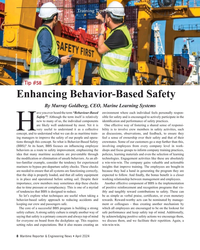 )
April 2024 - Maritime Reporter and Engineering News page: 8
)
April 2024 - Maritime Reporter and Engineering News page: 8Training Tips for Ships © By tuastockphoto/AdobeStock Tip #58 Enhancing Behavior-Based Safety By Murray Goldberg, CEO, Marine Learning Systems ave you ever heard the term “Behaviour-Based environment where each individual feels personally respon- Safety”? Although the term itself is relatively sible for
-
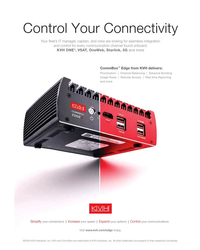 )
April 2024 - Maritime Reporter and Engineering News page: 5
)
April 2024 - Maritime Reporter and Engineering News page: 5Control Your Connectivity Your ?eet’s IT manager, captain, and crew are looking for seamless integration and control for every communication channel found onboard: ® KVH ONE , VSAT, OneWeb, Starlink, 5G and more ™ CommBox Edge from KVH delivers: Prioritization | Channel Balancing | Advance Bonding
-
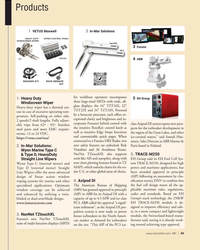 )
April 2024 - Marine News page: 43
)
April 2024 - Marine News page: 43Products 1 2 VETUS Maxwell In-Mar Solutions 3 Furuno ABB 4 for workboat operators encompasses EH Group 1. Heavy Duty 5 three large-sized MFDs with wide, all- Windscreen Wiper glass displays: the 16” TZT16X, 22” Heavy-duty wiper has a thermal cut- TZT22X and 24” TZT24X. Powered out in
-
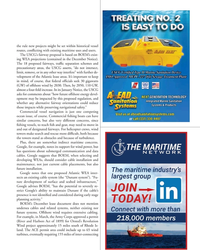 )
April 2024 - Marine News page: 23
)
April 2024 - Marine News page: 23the rule new projects might be set within historical vessel routes, con? icting with existing maritime uses and users. The USCG’s fairway proposal is based on BOEM’s exist- ing WEA projections (contained in the December Notice). The 18 proposed fairways, traf? c separation schemes and precautionary
-
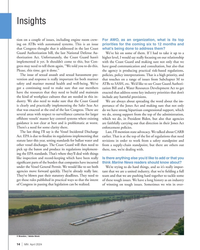 )
April 2024 - Marine News page: 14
)
April 2024 - Marine News page: 14Insights tion on a couple of issues, including engine room crew- For AWO, as an organization, what is its top ing on ATBs with automated systems. This is an issue priorities for the coming six to 12 months and that Congress thought that it addressed in the last Coast what’s being done to address them? Gua
-
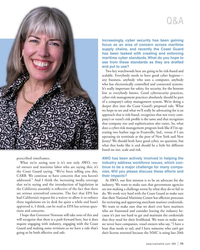 )
April 2024 - Marine News page: 11
)
April 2024 - Marine News page: 11Q&A Increasingly, cyber security has been gaining focus as an area of concern across maritime supply chains, and recently the Coast Guard has been tasked with creating and enforcing maritime cyber standards. What do you hope to see from these standards as they are drafted and put to use? Two key
-
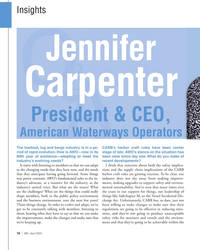 )
April 2024 - Marine News page: 10
)
April 2024 - Marine News page: 10Insights Jennifer QQQQQQQQQAAA & Carpenter President & CEO, American Waterways Operators The towboat, tug and barge industry is in a pe- CARB’s harbor craft rules have been center riod of rapid evolution. How is AWO—now in its stage of late. AWO’s stance on the situation has 80th year of existence—adapt
-
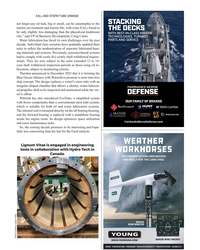 )
February 2024 - Maritime Reporter and Engineering News page: 33
)
February 2024 - Maritime Reporter and Engineering News page: 33EAL AND STERN TUBE DAMAGES STACKING not forget any oil leak, big or small, can be catastrophic to the marine environment and marine life, with some EALs found to THE DECKS be only slightly less damaging than the phased-out traditional WITH BEST-IN-CLASS MARINE oils,” said VP of Business Development
-
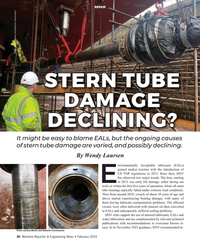 )
February 2024 - Maritime Reporter and Engineering News page: 30
)
February 2024 - Maritime Reporter and Engineering News page: 30REPAIR Photo courtesy Marine and Industrial Transmissions STERN TUBE DAMAGE DECLINING? It might be easy to blame EALs, but the ongoing causes of stern tube damage are varied, and possibly declining. By Wendy Laursen nvironmentally Acceptable lubricants (EALs) gained market traction with the introduction
-
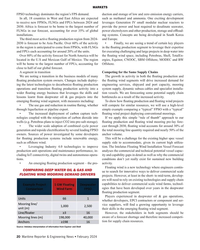 )
February 2024 - Maritime Reporter and Engineering News page: 20
)
February 2024 - Maritime Reporter and Engineering News page: 20MARKETS FPSO technology dominates the region’s FPS demand. duction and storage of low and zero emission energy carriers, In all, 18 countries in West and East Africa are expected such as methanol and ammonia. One exciting development to receive new FPSOs, FLNGs and FPUs between 2024 and leverages
-
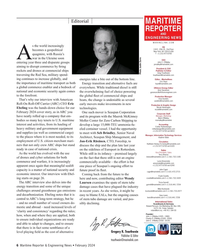 )
February 2024 - Maritime Reporter and Engineering News page: 6
)
February 2024 - Maritime Reporter and Engineering News page: 6Editorial MARITIME REPORTER AND ENGINEERING NEWS M A R I N E L I N K . C O M s the world increasingly HQ 118 E. 25th St., 2nd Floor becomes a geopolitical New York, NY 10010 USA T +1.212.477.6700 quagmire, with Russia’s Awar in the Ukraine soon CEO John C. O’Malley entering year three and disparate
-
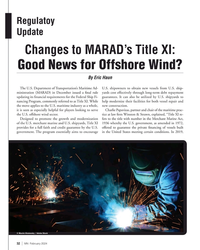 )
February 2024 - Marine News page: 32
)
February 2024 - Marine News page: 32Regulatoy Update Changes to MARAD’s Title XI: Good News for Offshore Wind? By Eric Haun The U.S. Department of Transportation’s Maritime Ad- U.S. shipowners to obtain new vessels from U.S. ship- ministration (MARAD) in December issued a ? nal rule yards cost effectively through long-term debt repayment
-
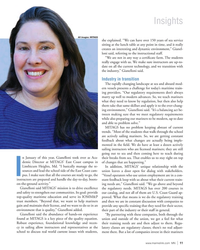 )
February 2024 - Marine News page: 11
)
February 2024 - Marine News page: 11employment are in a con- I instructors are prepared and handle the day-to-day, boots- stant feedback loop with us about what their current train- on-the-ground activity.” ing needs are,” Gianelloni said. “We go above and beyond Gianelloni said MITAGS’ mission is to drive excellence the regulatory needs.
-
 )
January 2024 - Marine Technology Reporter page: 37
)
January 2024 - Marine Technology Reporter page: 37of the Åland Islands in Finland and launched in 1993. tales to inform and engage others.” For the ? rst 10-day leg of the expedition, departing Svalbard GROUNDSWELL on September 1, 2023, the 18-strong team of scientists, citizen The Warrior programs, while training explorers, are also scientists and crew
-
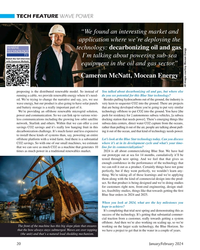 )
January 2024 - Marine Technology Reporter page: 20
)
January 2024 - Marine Technology Reporter page: 20do you see potential for this Blue Star technology? ed. We’re trying to change the narrative and say, yes, we use Besides pulling hydrocarbons out of the ground, the industry is wave energy, but our product is also going to have solar panels very keen to sequester CO2 into the ground. There are projects and
-
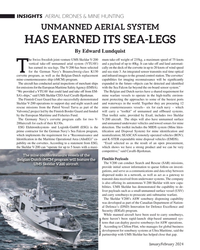 )
January 2024 - Marine Technology Reporter page: 12
)
January 2024 - Marine Technology Reporter page: 12and sea state 3. An integrated sensor transmits real time optical corvette program, as well as the Belgian-Dutch replacement and infrared images to the ground control station. The corvettes’ mine-countermeasures ship (rMCM) program. capabilities for imaging reconnaissance will be signi? cantly The aircraft
-
 )
January 2024 - Marine Technology Reporter page: 8
)
January 2024 - Marine Technology Reporter page: 8vehicles (USVs) the Black Sea has taken center stage as a kind of maritime have wreaked havoc on Russia’s Black Sea Fleet, damaging drone proving ground, Ukraine is not the only small actor re- several high-value warships, and driving others from Sevas- lying on underwater ingenuity and innovation.
-
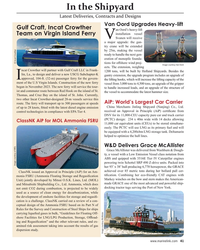 )
January 2024 - Maritime Reporter and Engineering News page: 41
)
January 2024 - Maritime Reporter and Engineering News page: 41In the Shipyard Latest Deliveries, Contracts and Designs Van Oord Upgrades Heavy-lift Gulf Craft, Incat Crowther an Oord’s heavy-lift installation vessel Team on Virgin Island Ferry VSvanen will receive a major upgrade: the gan- try crane will be extended by 25m, making the vessel ready to handle the
-
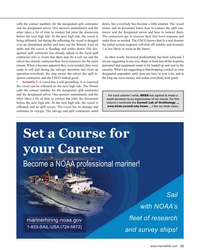 )
January 2024 - Maritime Reporter and Engineering News page: 11
)
January 2024 - Maritime Reporter and Engineering News page: 11cost a lot, and in sponse contractor, and the USCG looked good. the long run saves money and makes everybody look good. • Scenario 3. A vessel has a soft grounding. It is expected the vessel can be re? oated on the next high tide. The Owner calls the contact number for the designated spill contractor and
-
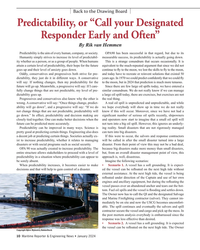 )
January 2024 - Maritime Reporter and Engineering News page: 10
)
January 2024 - Maritime Reporter and Engineering News page: 10, disastrous. be sorely absent. Imagine the following scenarios: When predictability increases, it becomes easier to make • Scenario 1. A vessel has a soft grounding. It is expect- decisions and that will help to gain control of a disaster. ed the vessel can be re? oated on the next high tide without external
